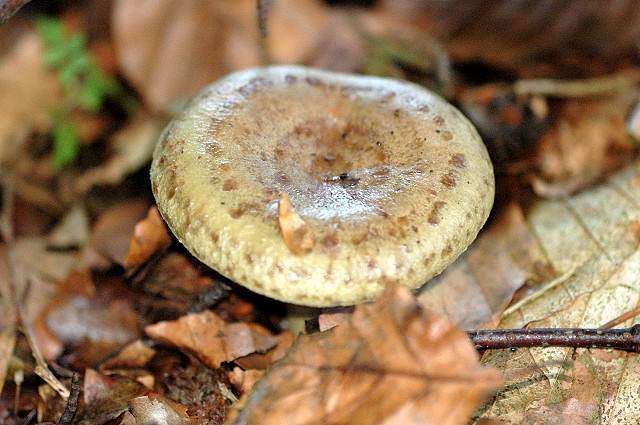- Lactarius blennius
Taxobox | name = "Lactarius blennius"

image_width = 200px
image_caption = "Lactarius blennius"
regnum = Fungi
divisio =Basidiomycota
class =Homobasidiomycetes
ordo =Russulales
familia =Russulaceae
genus = "Lactarius "
species = "L. blennius"
binomial = "Lactarius blennius"
binomial_authority = (Fr.) Fr.mycomorphbox
name = Lactarius blennius
whichGills = decurrent
capShape = convex
hymeniumType=gills
stipeCharacter=bare
ecologicalType=mycorrhizal
sporePrintColor=cream
howEdible=inedible"Lactarius blennius", commonly known as the slimy milk-cap, is a green-coloured mushroom of the genus "
Lactarius " found inbeech forests in Europe. Its edibility is uncertain, with different mycologists suggesting that it is edible, inedible or even poisonous. It has been the subject of research and several chemicals can be extracted from it.Taxonomy
"Lactarius blennius" was first described by Swedish mycologist
Elias Magnus Fries as "Agaricus blennius" in 1815, before being given its current binomial name by the same author in 1838. The specific epithet is derived from aLatin adjective "blennius" "slimy".cite book | last = Nilson|first= Sven |coauthors= Olle Persson | year = 1977 | title = Fungi of Northern Europe 2: Gill-Fungi | publisher = Penguin|isbn=0-14-063006-6|pages=p. 100]Description
"L. blennius" has a flattened convex cap that is 4-10 cm (1.6-4 in) across that later becomes depressed in the centre. In colour, it is pale olive to a greenish grey, sometimes a dull green or pale grey-sepia, and has blotches of darker colouration in
concentric bands.cite book |title= Mushrooms and Other Fungi of Great Britain and Europe|last= Phillips|first= Roger|year= 1981|publisher=Pan Books |location= London|isbn= 0330264419|pages= p. 83] The cap is very slimy when moist and has an incurved margin. The stem is a paler colour than the cap, but also very slimy, and measures from 4-5 cm (1.6-2 in) tall by 1-1.7 cm (0.4-0.7 in) thick, tapering a little towards the bottom.cite book |title= Mushrooms and Toadstools|last= Pegler|first= David N.|year= 1983|publisher= Mitchell Beazley Publishing|location= London|isbn= 0855335009|pages= 115] The flesh is whitish, similar in colour to the slightly decurrent gills, which later become a creamy or pale buff colour. The gills turn a brownish-grey colour when wounded. The milk is white and dries grey. "L. blennius" spores leave a creamy print, and areelliptic oramyloid with low warts joined by ridges with a small number of cross-connections, measuring from 6-9 by 5.5-7micrometre s.Distribution and habitat
"L. blennius" is very common and is found in broad-leaved woodland, favouring
beech . It is found between late summer and late autumn, and is native to Europe.Edibility
While some say that "L. blennius" is edible when cooked, but not recommended, others describe it as inedible or even poisonous.cite book |title= Edible and Poisonous Mushrooms of the World|last= Hall|first= Ian Robert|url= http://books.google.com/books?id=yqHA_M7BVRcC&pg=PA156&dq=%22Lactarius+blennius%22&lr=lang_en&as_brr=3&sig=ACfU3U22TY1RQbkXP_X2AeVmJ4xPByZfsg|accessdate= 2008-08-19|coauthors= Buchanan, Peter K.; Stephenson, Steven L.; Yun, Wang; Cole, Anthony L. J.|year= 2003|publisher=
Timber Press |isbn= 9780881925869|pages= 156] The milk tastes very hot and acrid.Other uses
"L. blennius" has been the subject of some research in
chemistry . Lactarane derivatives (known as "blennins") have been acquired from the mushroom, including thelactone blennin D, [cite book |title= Terpenes|last= Breitmaier|first= Eberhand|url= http://books.google.com/books?id=Zu3No7HWS8wC&pg=PA44&dq=Lactarius+blennius&lr=lang_en&as_brr=3&sig=ACfU3U2FJ419SrI3Sf3aece3ZjDungTQGA|accessdate= 2008-08-19|year= 2007|publisher=Wiley-VCH |isbn= 9783527609109|pages= 44] and blennin A, which was first isolated from this species. [cite journal |last= Lorenzen|first= K.|coauthors= Anke, T.|year= 1998|month= July|title= Basidiomycetes as a Source for New Bioactive Natural Products|journal= Current Organic Chemistry|volume= 2|issue= 4|pages= 329–354|url= http://books.google.com/books?id=aI_3BDcYKXgC&pg=PA348&dq=Lactarius+blennius+blennin&lr=lang_en&as_brr=3&sig=ACfU3U29ktCXKX1xtX8qbomXMochZN6yqQ#PPA348,M1|accessdate=2008-08-19 |issn= 1385-2728] "L. blennius" can also be refined to create a green pigment, known as blennione. [cite journal |last= Spiteller|first= Peter|coauthors= Steglich, Wolfgang|year= 2002|title= Blennione, a Green Aminobenzoquinone Derivative from Lactarius blennius|journal= Journal of Natural Products|volume= 65|issue= 5|pages= 725–727|issn= 0163-3864 |doi= 10.1021/np0106541]References
Wikimedia Foundation. 2010.
